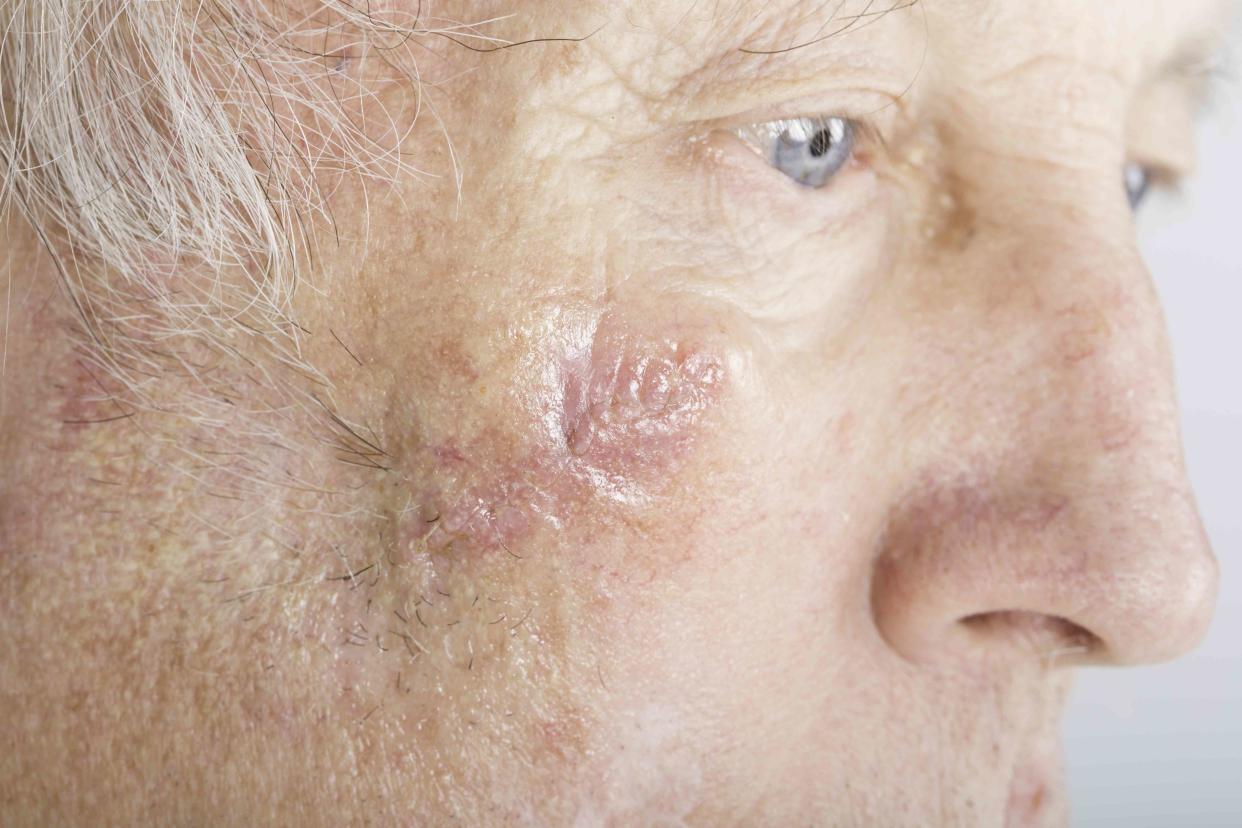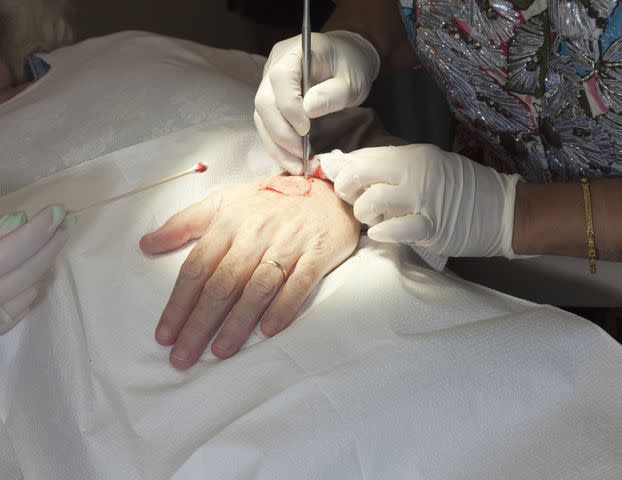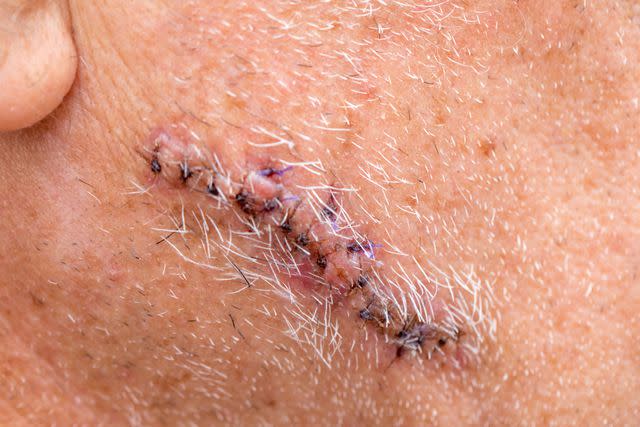What Is Mohs Surgery?

JodiJacobson / Getty Images
Medically reviewed by David Hampton, MD
Mohs surgery, also referred to as Mohs micrographic surgery, is a type of surgery used to treat and cure certain skin cancers. Mohs surgery has a high cure rate and is a method that can help you preserve as much healthy skin as possible.
This skin cancer treatment is performed by a trained Mohs surgeon (a dermatologist who has received extensive training in Mohs surgery). During surgery, the surgeon removes small samples of skin, and then examines them under a microscope for signs of cancer.
Purpose
The purpose of Mohs surgery is to treat and cure skin cancer. Your dermatologist may recommend Mohs surgery if you have basal cell carcinoma or squamous cell carcinoma.
During Mohs surgery, the surgeon removes the skin cancer growth and then removes layers of skin, examining each one under a microscope, to ensure that all cancer cells have been removed. This type of surgery is especially helpful for people who have skin cancer in an area of the body that does not have much tissue under it, such as the eyelid or ear.
This surgery is also helpful for people with skin cancer that is large, aggressive, or has recurred.
What About Melanoma?
Because melanoma skin cancer usually develops deeper in the skin, it is not usually treated with Mohs surgery. However, Mohs surgery may be effective at treating an early case of lentigo malignant melanoma, a type of melanoma that grows closer to the surface of the skin.
How Does It Work?
In most cases, Mohs surgery is an outpatient procedure, meaning you can go home the same day. During the surgery, your surgeon will remove any areas of skin cancer, as well as the surrounding skin to ensure that all cancer cells are gone.
Before the Surgery
Before Mohs surgery, your surgeon will discuss the procedure with you and explain the risks and benefits. They will likely recommend stopping certain medications like aspirin and blood thinners before surgery. Because these medications make it harder for your blood to clot, it is best to not take them to avoid excessive bleeding during surgery.
When you arrive for your appointment, you will be given paperwork to complete. If the paperwork was mailed to you or sent electronically, be sure to bring it with you. Plan to bring your insurance card and identification card as well.
In most cases, the surgeon performs Mohs surgery with local anesthetic. You will be awake and alert during the procedure. To numb the area, your surgeon will inject a numbing medication into the skin around the skin cancer.
During the Surgery
Once your skin is numb, your surgeon will begin the procedure by cutting the skin with a scalpel and removing the skin cancer growth. Once your surgeon has removed the areas of visible skin cancer, they will remove a thin layer of the surrounding skin to examine the cells under a microscope.
Your surgeon will place a pressure bandage over the incision site to prevent bleeding while they inspect your skin cells. One round of Mohs surgery usually takes about one hour to complete. The surgery takes between 10 and 20 minutes, and the microscope time takes 40 to 50 minutes.
If your surgeon sees cancer cells under the microscope, they will return to remove another layer of skin and examine it under a microscope. Most people undergoing Mohs surgery require two rounds, but larger or deeper tumors may take longer. Your skin will be numb during the entire procedure, so you should not expect to feel pain.
Once your surgeon no longer sees any cancer cells in your tissue sample, they will complete the procedure by closing the incision in the skin. Very small wounds may heal on their own. In most cases, the surgeon will close the incision with stitches and/or staples.
For large wounds, your surgeon may recommend a skin graft where the incision site is covered with skin from another part of the body. Another option is a skin flap where the incision site is covered with skin right next to the wound.

Jodi Jacobson / Getty Images
After the Surgery
After Mohs surgery is complete, your surgeon will close the wound and observe it for any signs of bleeding or complications. Most people can go home shortly after finishing Mohs surgery.
Even though you will feel awake and alert after surgery, most surgeons recommend arranging a ride home. Your surgeon will send you home with instructions on how to care for your wound and when to return for a follow-up appointment.
The goal of Mohs surgery is to cure skin cancer. Hopefully, you will not have to repeat this procedure. In rare cases, skin cancer comes back, and your surgeon may recommend another Mohs surgery.

Jodi Jacobson / Getty Images
Risks and Precautions
Mohs surgery is generally considered safe, and the benefits usually far outweigh the risks. However, as with any other surgery, there are risks to consider.
Risks of Mohs surgery include:
Infection: Signs of an infected incision site include redness, swelling, and pus.
Bleeding: If your wound keeps bleeding after surgery, call your surgeon.
Nerve damage: If a nerve is damaged during surgery, you may feel numbness or burning at the site. This usually goes away on its own as the nerve heals.
How to Prepare for Mohs Surgery
Going in for skin cancer surgery can feel scary. Knowing exactly what to expect can help.
Before Mohs surgery, consider the following details:
Location: In most cases, the surgeon performs Mohs surgery at an outpatient dermatology clinic or surgery center. In rare cases, the surgeon may recommend the operating room at a hospital.
Attire: Plan to wear loose, comfortable clothing to your appointment. Depending on where your skin cancer is located, you may be given a hospital gown to change into. Plan to leave any jewelry or valuables at home.
Food and drink: Most people can eat and drink normally before Mohs surgery because they do not need general anesthesia for the procedure. Ask your healthcare team if there are any changes you should make. Avoid alcohol and tobacco before surgery.
Medications: Discuss your medications with your surgeon prior to yourx surgery. They will recommend that you stop any medications that can increase the risk of bleeding during surgery. These include aspirin and blood thinners.
Items to bring: Plan to bring your insurance card, identification card, and any related paperwork to your surgery appointment. You may want to bring a book or something to read while you wait in between rounds of surgery.
Emotional support: Arrange for a friend or family member to drive you home after your surgery. Ask your healthcare team where they can wait during surgery.
Cost and insurance: Mohs surgery is an effective skin cancer treatment and should be covered by insurance. Before your appointment, call both your insurance company and hospital billing department to ask about the copay and your financial responsibilities.
Results
Mohs surgery is unique because the surgeon can see the results during surgery. Your surgeon will continue to remove layers of skin until all cancer cells are gone. Mohs surgery has a 99% cure rate, which means that it cures skin cancer in most people.
A Quick Review
Mohs surgery is a type of surgery used to treat certain skin cancers. Mohs surgery is usually recommended for people with basal cell carcinoma or squamous cell carcinoma.
Mohs surgery has a high cure rate and is recommended for people who have had skin cancer in the past. A Mohs surgeon (a specially-trained dermatologist) performs the surgery by numbing the skin and removing skin cancer with a scalpel. They then remove thin layers of surrounding skin and examine them under a microscope until all cancer cells are gone.
For more Health.com news, make sure to sign up for our newsletter!
Read the original article on Health.com.

